Seasonal and Interannual Trends of Oceanographic Parameters over 40 Years in the Northern Adriatic Sea in Relation to Nutrient Loadings Using the EMODnet Chemistry Data Portal
Abstract
1. Introduction
2. Materials and Methods
2.1. Study Site
2.2. Data Inventory and Processing
3. Results and Discussion
3.1. Seasonal Characteristics of Basin Scale Patterns
3.2. Annual and Seasonal Trends of Oceanographic Properties
3.3. Freshwater and Nutrient Discharges by the Po River
3.4. Comparison of River and Coastal Data in 1971–2005 and 2006–2015
4. Conclusions
- A positive trend of seawater temperature both in aggregated and seasonal data, which indicates A significant basin-scale warming of sea surface in this region;
- The decline in annual water discharge of the Po River in 1971–2005 and its recovery in 2006–2015, a trend that had important effects on the current biogeochemical conditions in the NAS on a basin scale.
- A significant positive trend of the salinity in aggregated data until 2007, with increases in spring and summer and a decrease in autumn, which agrees to the phase of low annual water discharges observed in 2003–2007 and to the seasonal changes of the frequency of the extreme high flows of the Po River in the same period;
- An increase in the frequency of extremely high Po River discharges in spring and early summer during the last decade, which could change the annual availability of nutrients in the NAS;
- Low and constant PO43ˉ concentration in seawater in the aggregated data and a further reduction in summer, which indicates a persistent PO43ˉ deficiency in the NAS consequent to the improvement of the environmental management practices in river drainage basins;
- A significant positive trend of NO3ˉ concentrations in seawater in almost all seasons during the last decade, notwithstanding a decreasing trend of its concentration in the Po river water, which can be explained by the rise of NO3−/PO43− ratio in river water and by an excess of NO3− in the marine environment that cannot be used by phytoplankton due to PO43− limitation;
- A phase of instable environmental conditions in 2008–2015, characterized by highly variable river water discharges, high Chl-a, NO3− and SiO2 concentrations and high NO3ˉ/PO43ˉ ratios in surface waters, which suggests that the effects of the most recent climate changes should be better analyzed in this marine region;
- The changes in nutrients dynamics, which indicates that the productivity of the NAS has been largely modulated in the last 40 years by the combination of river water discharges and human activities and that further changes have to be expected in the future, particularly in the case of a further reduction in anthropogenic phosphorus loads.
Author Contributions
Funding
Acknowledgments
Conflicts of Interest
Appendix A
| Seasons | Winter | Spring | Summer | Autumn |
|---|---|---|---|---|
| Discharge (m3 s−1) | ||||
| No. data | 2075 | 2093 | 2116 | 2116 |
| Mean | 1420 | 1835 | 1126 | 1850 |
| Standard Error | 13 | 18 | 12 | 24 |
| Minimum | 542 | 216 | 168 | 561 |
| Maximum | 5540 | 7120 | 7457 | 9517 |
| Nitrate (µM) | ||||
| No. data | 84 | 87 | 90 | 88 |
| Mean | 209 | 140 | 114 | 188 |
| Standard Error | 4.2 | 4.4 | 4.3 | 4.9 |
| Minimum | 121 | 43 | 8 | 92 |
| Maximum | 323 | 273 | 202 | 332 |
| Phosphate (µM) | ||||
| No. data | 81 | 81 | 75 | 87 |
| Mean | 2.35 | 1.89 | 1.76 | 2.47 |
| Standard Error | 0.07 | 0.06 | 0.09 | 0.09 |
| Minimum | 1.29 | 0.64 | 0.32 | 0.97 |
| Maximum | 4.84 | 3.87 | 5.81 | 5.48 |
| Month | Period | High Day Year−1 | Low Day Year−1 | Period | High Day Year−1 | Low Day Year−1 |
|---|---|---|---|---|---|---|
| January | 1971–2005 | 2.8 | 1.9 | 2006–2015 | 1.2 | 1.3 |
| February | 1971–2005 | 1.6 | 1.0 | 2006–2015 | 0.0 | 3.0 |
| March | 1971–2005 | 1.5 | 3.3 | 2006–2015 | 0.4 | 2.4 |
| April | 1971–2005 | 1.2 | 1.9 | 2006–2015 | 3.6 | 2.8 |
| May | 1971–2005 | 1.4 | 8.2 | 2006–2015 | 2.6 | 8.0 |
| June | 1971–2005 | 2.6 | 4.4 | 2006–2015 | 3.8 | 3.2 |
| July | 1971–2005 | 7.3 | 0.6 | 2006–2015 | 12.4 | 0.0 |
| August | 1971–2005 | 10.5 | 0.5 | 2006–2015 | 9.6 | 0.4 |
| September | 1971–2005 | 2.4 | 1.8 | 2006–2015 | 0.7 | 0.5 |
| October | 1971–2005 | 1.3 | 6.8 | 2006–2015 | 0.0 | 0.0 |
| November | 1971–2005 | 1.2 | 4.7 | 2006–2015 | 1.2 | 6.8 |
| December | 1971–2005 | 2.7 | 2.3 | 2006–2015 | 0.4 | 4.9 |
References
- Marini, M.; Jones, B.H.; Campanelli, A.; Grilli, F.; Lee, C.M. Seasonal variability and Po River plume influence on biochemical properties along western Adriatic coast. J. Geophys. Res. 2008, 113, 1–18. [Google Scholar] [CrossRef]
- Harley, C.D.G.; Hughes, A.R.; Hultgren, K.M.; Miner, B.G.; Sorte, C.J.B.; Thornber, C.S.; Rodriguez, L.F.; Tomanek, L.; Williams, S.L. The impacts of climate change in coastal marine systems. Ecol. Lett. 2006, 9, 228–241. [Google Scholar] [CrossRef]
- Kraus, R.; Grilli, F.; Supić, N.; Janeković, I.; Brailo, M.; Cara, M.; Cetinić, A.B.; Campanelli, A.; Cozzi, S.; D’Adamo, R.; et al. Oceanographic characteristics of the Adriatic Sea–Support to secondary HAOP spread through natural dispersal. Mar. Pollut. Bull. 2019, 147, 59–85. [Google Scholar] [CrossRef] [PubMed]
- Coll, M.; Piroddi, C.; Albouy, C.; Ben Rais Lasram, F.; Cheung, W.W.L.; Christensen, V.; Karpouzi, V.S.; Guilhaumon, F.; Mouillot, D.; Paleczny, M.; et al. The Mediterranean Sea under siege: Spatial overlap between marine biodiversity, cumulative threats and marine reserves. Glob. Ecol. Biogeogr. 2012, 21, 465–480. [Google Scholar] [CrossRef]
- Ramírez, F.; Coll, M.; Navarro, J.; Bustamante, J.; Green, A.J. Spatial congruence between multiple stressors in the Mediterranean Sea may reduce its resilience to climate impacts. Sci. Rep. 2018, 8, 14878. [Google Scholar] [CrossRef] [PubMed]
- Neumann, B.; Vafeidis, A.T.; Zimmermann, J.; Nicholls, R.J. Future coastal population growth and exposure to sea-level rise and coastal flooding—A global assessment. PLoS ONE 2015, 10, e0118571. [Google Scholar] [CrossRef]
- Penna, N.; Capellacci, S.; Ricci, F. The influence of the Po River discharge on phytoplankton bloom dynamics along the coastline of Pesaro (Italy) in the Adriatic Sea. Mar. Pollut. Bull. 2004, 48, 321–326. [Google Scholar] [CrossRef]
- Schiano, M.E.; Sparnocchia, S.; Cappa, C.; Bozzano, R. An analysis of the climate variability over the Mediterranean sea by means of the surface water vapour density. Int. J. Climatol. 2005, 25, 1731–1748. [Google Scholar] [CrossRef]
- Grbec, B.; Morović, M.; Beg Paklar, G.; Kušpilić, G.; Matijević, S.; Matić, F.; Gladan, Ž.N. The relationship between the atmospheric variability and productivity in the adriatic Sea area. J. Mar. Biol. Assoc. UK 2009, 89, 1549–1558. [Google Scholar] [CrossRef]
- Giani, M.; Djakovac, T.; Degobbis, D.; Cozzi, S.; Solidoro, C.; Umani, S.F. Recent changes in the marine ecosystems of the northern Adriatic Sea. Estuar. Coast. Shelf Sci. 2012, 115, 1–13. [Google Scholar] [CrossRef]
- Djakovac, T.; Supić, N.; Bernardi Aubry, F.; Degobbis, D.; Giani, M. Mechanisms of hypoxia frequency changes in the northern Adriatic Sea during the period 1972–2012. J. Mar. Syst. 2015, 141, 179–189. [Google Scholar] [CrossRef]
- Furlan, E.; Torresan, S.; Critto, A.; Lovato, T.; Solidoro, C.; Lazzari, P.; Marcomini, A. Cumulative Impact Index for the Adriatic Sea: Accounting for interactions among climate and anthropogenic pressures. Sci. Total Environ. 2019, 670, 379–397. [Google Scholar] [CrossRef] [PubMed]
- Grbec, B.; Dulčić, J.; Morović, M. Long-term changes in landings of small pelagic fish in the eastern Adriatic—Possible influence of climate oscillations over the Northern Hemisphere. Clim. Res. 2002, 20, 241–252. [Google Scholar] [CrossRef]
- Coll, M.; Santojanni, A.; Palomera, I.; Arneri, E. Ecosystem assessment of the North-Central Adriatic Sea: Towards a multivariate reference framework. Mar. Ecol. Prog. Ser. 2010, 417, 193–210. [Google Scholar] [CrossRef]
- Cabrini, M.; Cerino, F.; de Olazabal, A.; Di Poi, E.; Fabbro, C.; Fornasaro, D.; Goruppi, A.; Flander-Putrle, V.; Francé, J.; Gollasch, S.; et al. Potential transfer of aquatic organisms via ballast water with a particular focus on harmful and non-indigenous species: A survey from Adriatic ports. Mar. Pollut. Bull. 2019, 147, 16–35. [Google Scholar] [CrossRef] [PubMed]
- Marini, M.; Russo, A.; Paschini, E.; Grilli, F.; Campanelli, A. Short-term physical and chemical variations in the bottom water of middle Adriatic depressions. Clim. Res. 2006, 31, 227–237. [Google Scholar] [CrossRef]
- Lipizer, M.; Partescano, E.; Rabitti, A.; Giorgetti, A.; Crise, A. Qualified temperature, salinity and dissolved oxygen climatologies in a changing Adriatic Sea. Ocean Sci. 2014, 10, 771–797. [Google Scholar] [CrossRef]
- Scarascia, P.L.L. The relation between climate change in the Mediterranean region and global warming. Reg. Environ. Chang. 2018, 18, 1481–1493. [Google Scholar]
- García-Martínez, M.d.C.; Vargas-Yáñez, M.; Moya, F.; Santiago, R.; Muñoz, M.; Reul, A.; Ramírez, T.; Balbín, R. Average nutrient and chlorophyll distributions in the western Mediterranean: RADMED project. Oceanologia 2019, 61, 143–169. [Google Scholar] [CrossRef]
- Brunetti, M.; Maugeri, M.; Nanni, T. Changes in total precipitation, rainy days and extreme events in Northeastern Italy. Int. J. Climatol. 2001, 21, 861–871. [Google Scholar] [CrossRef]
- Alfieri, L.; Bisselink, B.; Dottori, F.; Naumann, G.; de Roo, A.; Salamon, P.; Wyser, K.; Feyen, L. Global projections of river flood risk in a warmer world. Earth’s Future 2017, 5, 171–182. [Google Scholar] [CrossRef]
- Zoppini, A.; Ademollo, N.; Bensi, M.; Berto, D.; Bongiorni, L.; Campanelli, A.; Casentini, B.; Patrolecco, L.; Amalfitano, S. Impact of a river flood on marine water quality and planktonic microbial communities. Estuar. Coast. Shelf Sci. 2019, 224, 62–72. [Google Scholar] [CrossRef]
- Brugnara, Y.; Brunetti, M.; Maugeri, M.; Nanni, T.; Simolo, C. High-resolution analysis of daily precipitation trends in the central Alps over the last century. Int. J. Climatol. 2012, 32, 1406–1422. [Google Scholar] [CrossRef]
- Lionello, P.; Abrantes, F.; Congedi, L.; Dulac, F.; Gacic, M.; Gomis, D.; Goodess, C.; Hoff, H.; Kutiel, H.; Luterbacher, J.; et al. Introduction: Mediterranean climate-background information. In The Climate of the Mediterranean Region: From the Past to the Future; Elsevier Inc.: Waltham, MA, USA, 2012. [Google Scholar]
- Ulbrich, U.; Xoplaki, E.; Dobricic, S.; García-Herrera, R.; Lionello, P.; Adani, M.; Baldi, M.; Barriopedro, D.; Coccimiglio, P.; Dalu, G.; et al. Past and Current Climate Changes in the Mediterranean Region. In Regional Assessment of Climate Change in the Mediterranean; Navarra, A., Tubiana, L., Eds.; Springer: Dordrecht, The Netherlands, 2013; pp. 9–52. ISBN 978-94-007-5780-6. [Google Scholar]
- Grilli, F.; Marini, M.; Degobbis, D.; Ferrari, C.R.; Fornasiero, P.; Russo, A.; Gismondi, M.; Djakovac, T.; Precali, R.; Simonetti, R. Circulation and horizontal fluxes in the northern Adriatic Sea in the period June 1999–July 2002. Part II: Nutrients transport. Sci. Total Environ. 2005, 353, 115–125. [Google Scholar] [CrossRef]
- Djakovac, T.; Degobbis, D.; Supić, N.; Precali, R. Marked reduction of eutrophication pressure in the northeastern Adriatic in the period 2000–2009. Estuar. Coast. Shelf Sci. 2012, 115, 25–32. [Google Scholar] [CrossRef]
- Morabito, G.; Mazzocchi, M.G.; Salmaso, N.; Zingone, A.; Bergami, C.; Flaim, G.; Accoroni, S.; Basset, A.; Bastianini, M.; Belmonte, G.; et al. Plankton dynamics across the freshwater, transitional and marine research sites of the LTER-Italy Network. Patterns, fluctuations, drivers. Sci. Total Environ. 2018, 627, 373–387. [Google Scholar] [CrossRef]
- Pirrone, N.; Trombino, G.; Cinnirella, S.; Algieri, A.; Bendoricchio, G.; Palmeri, L. The Driver-Pressure-State-Impact-Response (DPSIR) approach for integrated catchment-coastal zone management: Preliminary application to the Po catchment-Adriatic Sea coastal zone system. Reg. Environ. Chang. 2005, 5, 111–137. [Google Scholar] [CrossRef]
- Santojanni, A.; Arneri, E.; Bernardini, V.; Cingolani, N.; Di Marco, M.; Russo, A. Effects of environmental variables on recruitment of anchovy in the Adriatic Sea. Clim. Res. 2006, 31, 181–193. [Google Scholar] [CrossRef]
- Cheung, W.W.L.; Lam, V.W.Y.; Sarmiento, J.L.; Kearney, K.; Watson, R.; Pauly, D. Projecting global marine biodiversity impacts under climate change scenarios. Fish Fish. 2009, 10, 235–251. [Google Scholar] [CrossRef]
- Azzurro, E.; Moschella, P.; Maynou, F. Tracking signals of change in mediterranean fish diversity based on local ecological knowledge. PLoS ONE 2011, 6, e24885. [Google Scholar] [CrossRef]
- Albouy, C.; Guilhaumon, F.; Leprieur, F.; Lasram, F.B.R.; Somot, S.; Aznar, R.; Velez, L.; Le Loc’h, F.; Mouillot, D. Projected climate change and the changing biogeography of coastal Mediterranean fishes. J. Biogeogr. 2013, 40, 534–547. [Google Scholar] [CrossRef]
- Cozzi, S.; Giani, M. River water and nutrient discharges in the Northern Adriatic Sea: Current importance and long term changes. Cont. Shelf Res. 2011, 31, 1881–1893. [Google Scholar] [CrossRef]
- Tedesco, L.; Socal, G.; Bianchi, F.; Acri, F.; Veneri, D.; Vichi, M. NW Adriatic Sea biogeochemical variability in the last 20 years (1986–2005). Biogeosciences 2007, 4, 673–687. [Google Scholar] [CrossRef]
- Solidoro, C.; Bastianini, M.; Bandelj, V.; Codermatz, R.; Cossarini, G.; Canu, D.M.; Ravagnan, E.; Salon, S.; Trevisani, S. Current state, scales of variability, and trends of biogeochemical properties in the northern Adriatic Sea. J. Geophys. Res. Ocean. 2009, 114, 1–21. [Google Scholar] [CrossRef]
- Vilibić, I.; Zemunik, P.; Šepić, J.; Dunić, N.; Marzouk, O.; Mihanović, H.; Denamiel, C.; Precali, R.; Djakovac, T. Present climate trends and variability in thermohaline properties of the northern Adriatic shelf. Ocean Sci. 2019, 15, 1351–1362. [Google Scholar] [CrossRef]
- Artegiani, A.; Bregant, D.; Paschini, E.; Pinardi, N.; Raicich, F.; Russo, A. The Adriatic Sea General Circulation. Part I: Air–Sea Interactions and Water Mass Structure. J. Phys. Oceanogr. 1997, 27, 1492–1514. [Google Scholar] [CrossRef]
- Poulain, P.M.; Cushman-Roisin, B. Circulation. In Physical Oceanography of the Adriatic Sea; Cushman-Roisin, B., Gacic, M., Poulain, P.-M., Artegiani, A., Eds.; Kluwer Academic: Dordrecht, The Netherlands, 2001; pp. 67–109. ISBN 1-4020-0225-4. [Google Scholar]
- Orlic, M.; Gacic, M.; La Violette, P.E. The currents and circulation of the Adriatic Sea. Oceanol. Acta 1992, 15, 109–124. [Google Scholar]
- Grilli, F.; Marini, M.; Book, J.W.; Campanelli, A.; Paschini, E.; Russo, A. Flux of nutrients between the middle and southern Adriatic Sea (Gargano-Split Section). Mar. Chem. 2013, 153, 1–14. [Google Scholar] [CrossRef]
- Boldrin, A.; Carniel, S.; Giani, M.; Marini, M.; Bernardi Aubry, F.; Campanelli, A.; Grilli, F.; Russo, A. Effects of bora wind on physical and biogeochemical properties of stratified waters in the northern Adriatic. J. Geophys. Res. 2009, 114, C08S92. [Google Scholar] [CrossRef]
- Gačić, M.; Eusebi Borzelli, G.L.; Civitarese, G.; Cardin, V.; Yari, S. Can internal processes sustain reversals of the ocean upper circulation? The Ionian Sea example. Geophys. Res. Lett. 2010, 37, 1–5. [Google Scholar] [CrossRef]
- Gačić, M.; Civitarese, G.; Kovačcević, V.; Ursella, L.; Bensi, M.; Menna, M.; Cardin, V.; Poulain, P.M.; Cosoli, S.; Notarstefano, G.; et al. Extreme winter 2012 in the adriatic: An example of climatic effect on the biOS rhythm. Ocean Sci. 2014, 10, 513–522. [Google Scholar] [CrossRef]
- Zavatarelli, M.; Raicich, F.; Bregant, D.; Russo, A.; Artegiani, A. Climatological biogeochemical characteristics of the Adriatic Sea. J. Mar. Syst. 1998, 18, 227–263. [Google Scholar] [CrossRef]
- Kraus, R.; Supić, N. Impact of circulation on high phytoplankton blooms and fish catch in the northern Adriatic (1990–2004). Estuar. Coast. Shelf Sci. 2011, 91, 198–210. [Google Scholar] [CrossRef]
- Kraus, R.; Supic, N.; Precali, R. Factors favouring phytoplankton blooms in the northern Adriatic: Towards the northern Adriatic empirical ecological model. Ocean Sci. 2016, 12, 19–37. [Google Scholar] [CrossRef]
- Muelbert, J.H.; Nidzieko, N.J.; Acosta, A.T.R.; Beaulieu, S.E.; Bernardino, A.F.; Boikova, E.; Bornman, T.G.; Cataletto, B.; Deneudt, K.; Eliason, E.; et al. Ilter—The international long-term ecological research network as a platform for global coastal and ocean observation. Front. Mar. Sci. 2019, 6, 527. [Google Scholar] [CrossRef]
- Acri, F.; Bastianini, M.; Bernardi Aubry, F.; Camatti, E.; Boldrin, A.; Bergami, C.; Cassin, D.; De Lazzari, A.; Finotto, S.; Minelli, A.; et al. A long-term (1965–2015) ecological marine database from the LTER-Italy Northern Adriatic Sea site: Plankton and oceanographic observations. Earth Syst. Sci. Data 2020, 12, 215–230. [Google Scholar] [CrossRef]
- Kralj, M.; Lipizer, M.; Čermelj, B.; Celio, M.; Fabbro, C.; Brunetti, F.; Francé, J.; Mozetič, P.; Giani, M. Hypoxia and dissolved oxygen trends in the northeastern Adriatic Sea (Gulf of Trieste). Deep. Res. Part. II Top. Stud. Oceanogr. 2019, 164, 74–88. [Google Scholar] [CrossRef]
- Míguez, B.M.; Novellino, A.; Vinci, M.; Claus, S.; Calewaert, J.B.; Vallius, H.; Schmitt, T.; Pititto, A.; Giorgetti, A.; Askew, N.; et al. The European Marine Observation and Data Network (EMODnet): Visions and roles of the gateway to marine data in Europe. Front. Mar. Sci. 2019, 6, 313. [Google Scholar] [CrossRef]
- Giorgetti, A.; Partescano, E.; Barth, A.; Buga, L.; Gatti, J.; Giorgi, G.; Iona, A.; Lipizer, M.; Holdsworth, N.; Larsen, M.M.; et al. EMODnet Chemistry Spatial Data Infrastructure for marine observations and related information. Ocean Coast. Manag. 2018, 166, 9–17. [Google Scholar] [CrossRef]
- Ravaioli, M.; Bergami, C.; Riminucci, F.; Aracri, S.; Aliani, S.; Bastianini, M.; Bergamasco, A.; Bommarito, C.; Borghini, M.; Bozzano, R.; et al. The RITMARE Italian Fixed-Point Observatory Network (IFON) for marine environmental monitoring: A case study. J. Oper. Oceanogr. 2016, 9, s202–s214. [Google Scholar] [CrossRef][Green Version]
- R Core Team. R: A Language and Environment for Statistical Computing; R Foundation for Statistical Computing: Vienna, Austria, 2019. [Google Scholar]
- Ofungwu, J. Statistical Applications for Environmental Analysis and Risk Assessment. Int. Stat. Rev. 2014, 82, 487–488. [Google Scholar]
- Totti, C.; Romagnoli, T.; Accoroni, S.; Coluccelli, A.; Pellegrini, M.; Campanelli, A.; Grilli, F.; Marini, M. Phytoplankton communities in the northwestern Adriatic Sea: Interdecadal variability over a 30-years period (1988–2016) and relationships with meteoclimatic drivers. J. Mar. Syst. 2019, 193, 137–153. [Google Scholar] [CrossRef]
- Campanelli, A.; Fornasiero, P.; Marini, M. Physical and chemical characterization of the water column in the Piceno coastal area (Adriatic sea). Fresenius Environ. Bull. 2004, 13, 430–435. [Google Scholar]
- Marini, M.; Campanelli, A.; Sanxhaku, M.; Zoran, K.; Mattia, B.; Grilli, F. Late spring characterization of different coastal areas of the Adriatic Sea. Acta Adriat. 2015, 56, 27–46. [Google Scholar]
- Specchiulli, A.; Bignami, F.; Marini, M.; Fabbrocini, A.; Scirocco, T.; Campanelli, A.; Penna, P.; Santucci, A.; Adamo, R.D. Estuarine, Coastal and Shelf Science The role of forcing agents on biogeochemical variability along the southwestern Adriatic coast: The Gulf of Manfredonia case study. Estuar. Coast. Shelf Sci. 2016, 183, 136–149. [Google Scholar] [CrossRef]
- Artegiani, A.; Bregant, D.; Paschini, E.; Pinardi, N.; Raicich, F.; Russo, A. The Adriatic Sea general circulation. Part II: Baroclinic circulation structure. J. Phys. Oceanogr. 1997, 27, 1515–1532. [Google Scholar] [CrossRef]
- Bergamasco, A.; Miro, G. Baroclinic Response of the Adriatic Sea to an Episode of Bora Wind. J. Phys. Oceanogr. 1996, 26, 1354–1369. [Google Scholar] [CrossRef]
- Kourafalou, V.H. River plume development in semi-enclosed Mediterranean regions: North Adriatic Sea and Northwestern Aegean Sea. J. Mar. Syst. 2001, 30, 181–205. [Google Scholar] [CrossRef]
- Bignami, F.; Sciarra, R.; Carniel, S.; Santoleri, R. Variability of Adriatic Sea coastal turbid waters from SeaWiFS imagery. J. Geophys. Res. Ocean. 2007, 112, 1–20. [Google Scholar] [CrossRef]
- Viaroli, P.; Soana, E.; Pecora, S.; Laini, A.; Naldi, M.; Fano, E.A.; Nizzoli, D. Space and time variations of watershed N and P budgets and their relationships with reactive N and P loadings in a heavily impacted river basin (Po River, Northern Italy). Sci. Total Environ. 2018, 639, 1574–1587. [Google Scholar] [CrossRef]
- Cozzi, S.; Ibáñez, C.; Lazar, L.; Raimbault, P.; Giani, M. Flow regime and nutrient-loading trends from the largest South European watersheds: Implications for the productivity of mediterranean and Black Sea’s Coastal Areas. Water (Switz.) 2019, 11, 1. [Google Scholar] [CrossRef]
- Falcieri, F.M.; Benetazzo, A.; Sclavo, M.; Russo, A.; Carniel, S. Po River plume pattern variability investigated from model data. Cont. Shelf Res. 2014, 87, 84–95. [Google Scholar] [CrossRef]
- Raicich, F.; Colucci, R.R. A near-surface sea temperature time series from Trieste, northern Adriatic Sea (1899–2015). Earth Syst. Sci. Data 2019, 11, 761–768. [Google Scholar] [CrossRef]
- Pisano, A.; Marullo, S.; Artale, V.; Falcini, F.; Yang, C.; Leonelli, F.E.; Santoleri, R.; Nardelli, B.B. New evidence of Mediterranean climate change and variability from Sea Surface Temperature observations. Remote Sens. 2020, 12, 132. [Google Scholar] [CrossRef]
- Russo, A.; Rabitti, S.; Bastianini, M. Decadal Climatic Anomalies in the Northern Adriatic Sea Inferred from a New Oceanographic Data Set. Mar. Ecol. 2002, 23, 340–351. [Google Scholar] [CrossRef]
- Brunetti, M.; Maugeri, M.; Monti, F.; Nanni, T. Temperature and precipitation variability in Italy in the last two centuries from homogenised instrumental time series. Int. J. Climatol. 2006, 26, 345–381. [Google Scholar] [CrossRef]
- Crespi, A.; Brunetti, M.; Lentini, G.; Maugeri, M. 1961–1990 high-resolution monthly precipitation climatologies for Italy. Int. J. Climatol. 2018, 38, 878–895. [Google Scholar] [CrossRef]
- Colella, S.; Falcini, F.; Rinaldi, E.; Sammartino, M.; Santoleri, R. Mediterranean ocean colour chlorophyll trends. PLoS ONE 2016, 11, e0155756. [Google Scholar] [CrossRef]
- Mélin, F.; Vantrepotte, V.; Clerici, M.; D’Alimonte, D.; Zibordi, G.; Berthon, J.F.; Canuti, E. Multi-sensor satellite time series of optical properties and chlorophyll-a concentration in the Adriatic Sea. Prog. Oceanogr. 2011, 91, 229–244. [Google Scholar] [CrossRef]
- Alvisi, F.; Cozzi, S. Seasonal dynamics and long-term trend of hypoxia in the coastal zone of Emilia Romagna (NW Adriatic Sea, Italy). Sci. Total Environ. 2016, 541, 1448–1462. [Google Scholar] [CrossRef]
- Kim, I.N.; Lee, K.; Gruber, N.; Karl, D.M.; Bullister, J.L.; Yang, S.; Kim, T.W. Increasing anthropogenic nitrogen in the North Pacific Ocean. Science 2014, 346, 1102–1106. [Google Scholar] [CrossRef] [PubMed]
- Degobbis, D.; Precali, R.; Ferrari, C.R.; Djakovac, T.; Rinaldi, A.; Ivančić, I.; Gismondi, M.; Smodlaka, N. Changes in nutrient concentrations and ratios during mucilage events in the period 1999–2002. Sci. Total Environ. 2005, 353, 103–114. [Google Scholar] [CrossRef] [PubMed]
- Palmeri, L.; Bendoricchio, G.; Artioli, Y. Modelling nutrient emissions from river systems and loads to the coastal zone: Po River case study, Italy. Ecol. Modell. 2005, 184, 37–53. [Google Scholar] [CrossRef]
- Giani, M.; Cozzi, S.; Tartari, G. Tendenze dei carichi di nutrienti riversati dal fiume Po nel Mare Adriatico. Biol. Mar. Mediterr. 2018, 25, 23–26. [Google Scholar]
- Campanelli, A.; Grilli, F.; Paschini, E.; Marini, M. The influence of an exceptional Po River flood on the physical and chemical oceanographic properties of the Adriatic Sea. Dyn. Atmos. Ocean. 2011, 52, 284–297. [Google Scholar] [CrossRef]
- Raymond, F.; Ullmann, A.; Camberlin, P. Précipitations intenses sur le Bassin Méditerranéen: Quelles tendances entre 1950 et 2013 ? Intense rainfalls in the Mediterranean Basin: Which trends between 1950 and 2013? Cybergeo 2016, 1–17. [Google Scholar] [CrossRef]
- Haylock, M.R.; Peterson, T.C.; Alves, L.M.; Ambrizzi, T.; Anunciação, Y.M.T.; Baez, J.; Barros, V.R.; Berlato, M.A.; Bidegain, M.; Coronel, G.; et al. Trends in total and extreme South American rainfall in 1960–2000 and links with sea surface temperature. J. Clim. 2006, 19, 1490–1512. [Google Scholar] [CrossRef]
- Groisman, P.Y.; Knight, R.W.; Karl, T.R.; Easterling, D.R.; Sun, B.; Lawrimore, J.H. Contemporary changes of the hydrological cycle over the contiguous United States: Trends derived from in situ observations. J. Hydrometeorol. 2004, 5, 64–85. [Google Scholar] [CrossRef]
- Higgins, R.W.; Silva, V.B.S.; Shi, W.; Larson, J. Relationships between climate variability and fluctuations in daily precipitation over the United States. J. Clim. 2007, 20, 3561–3579. [Google Scholar] [CrossRef]
- Klein Tank, A.M.G.; Können, G.P. Trends in indices of daily temperature and precipitations extremes in Morocco. J. Clim. 2003, 16, 3665–3680. [Google Scholar] [CrossRef]
- IPCC. Climate Change 2007: The Physical Science Basis. Contribution of Working Group I to the Fourth Assessment Report of the Intergovernmental Panel on Climate Change; Solomon, S., Qin, D., Manning, M., Chen, Z., Marquis, M., Averyt, K.B., Tignor, M., Miller, H.L., Eds.; Cambridge University Press: Cambridge, UK; New York, NY, USA, 2007. [Google Scholar]
- Naldi, M.; Pierobon, E.; Tornatore, F.; Viaroli, P. Il ruolo degli eventi di piena nella formazione e distribuzione temporale dei carichi di fosforo e azoto nel fiume Po. Biol. Ambient. 2010, 24, 59–69. [Google Scholar]
- Zoboli, O.; Viglione, A.; Rechberger, H.; Zessner, M. Impact of reduced anthropogenic emissions and century flood on the phosphorus stock, concentrations and stocks in the Upper Danube. Sci. Total Environ. 2015, 518, 117–129. [Google Scholar] [CrossRef] [PubMed]
- Mozetič, P.; Solidoro, C.; Cossarini, G.; Socal, G.; Precali, R.; Francé, J.; Bianchi, F.; De Vittor, C.; Smodlaka, N.; Fonda Umani, S. Recent trends towards oligotrophication of the northern adriatic: Evidence from chlorophyll a time series. Estuaries Coasts 2010, 33, 362–375. [Google Scholar] [CrossRef]
- Braga, F.; Zaggia, L.; Bellafiore, D.; Bresciani, M.; Giardino, C.; Lorenzetti, G.; Maicu, F.; Manzo, C.; Riminucci, F.; Ravaioli, M.; et al. Mapping turbidity patterns in the Po river prodelta using multi-temporal Landsat 8 imagery. Estuar. Coast. Shelf Sci. 2017, 198, 555–567. [Google Scholar] [CrossRef]
- Grilli, F.; Paschini, E.; Precali, R.; Russo, A.; Supić, N. Circulation and horizontal fluxes in the northern Adriatic Sea in the period June 1999–July 2002. Part I: Geostrophic circulation and current measurement. Sci. Total Environ. 2005, 353, 57–67. [Google Scholar] [CrossRef]
- Copetti, D.; Carniato, L.; Crise, A.; Guyennon, N.; Palmeri, L.; Pisacane, G.; Struglia, M.V.; Gianni, T. Impacts of Climate Change on Water Quality. In Regional Assessment of Climate Change in the Mediterranean. Advances in Global Change Research; Navarra, A., Tubiana, L., Eds.; Springer: Dordrecht, The Netherlands, 2013; Volume 50, pp. 307–332. ISBN 978-94-007-5780-6. [Google Scholar]
- Bernardi Aubry, F.; Berton, A.; Bastianini, M.; Socal, G.; Acri, F. Phytoplankton succession in a coastal area of the NW Adriatic, over a 10-year sampling period (1990–1999). Cont. Shelf Res. 2004, 24, 97–115. [Google Scholar] [CrossRef]
- Fonda Umani, S.; Milani, L.; Borme, D.; De Olazabal, A.; Parlato, S.; Precali, R.; Kraus, R.; Lučić, D.; Njire, J.; Totti, C.; et al. Inter-annual variations of planktonic food webs in the northern Adriatic Sea. Sci. Total Environ. 2005, 353, 218–231. [Google Scholar] [CrossRef]
- Kharin, V.V.; Zwiers, F.W. Changes in the extremes in an ensemble of transient climate simulations with a coupled atmosphere-ocean GCM. J. Clim. 2000, 13, 3760–3788. [Google Scholar] [CrossRef]
- Zanchettin, D.; Rubino, A.; Traverso, P.; Tomasino, M. Impact of variations in solar activity on hydrological decadal patterns in northern Italy. J. Geophys. Res. Atmos. 2008, 113, 1–12. [Google Scholar] [CrossRef]
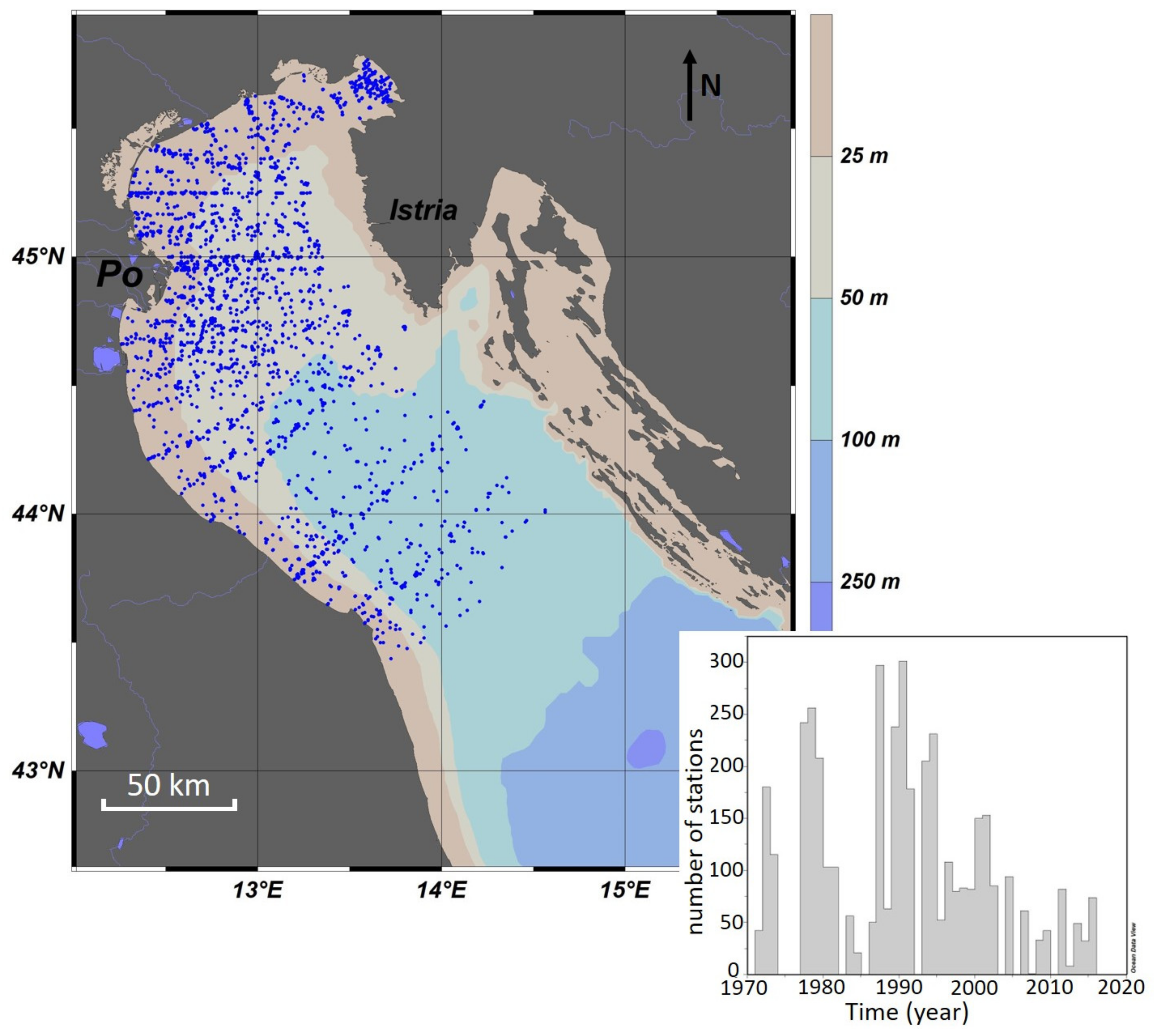
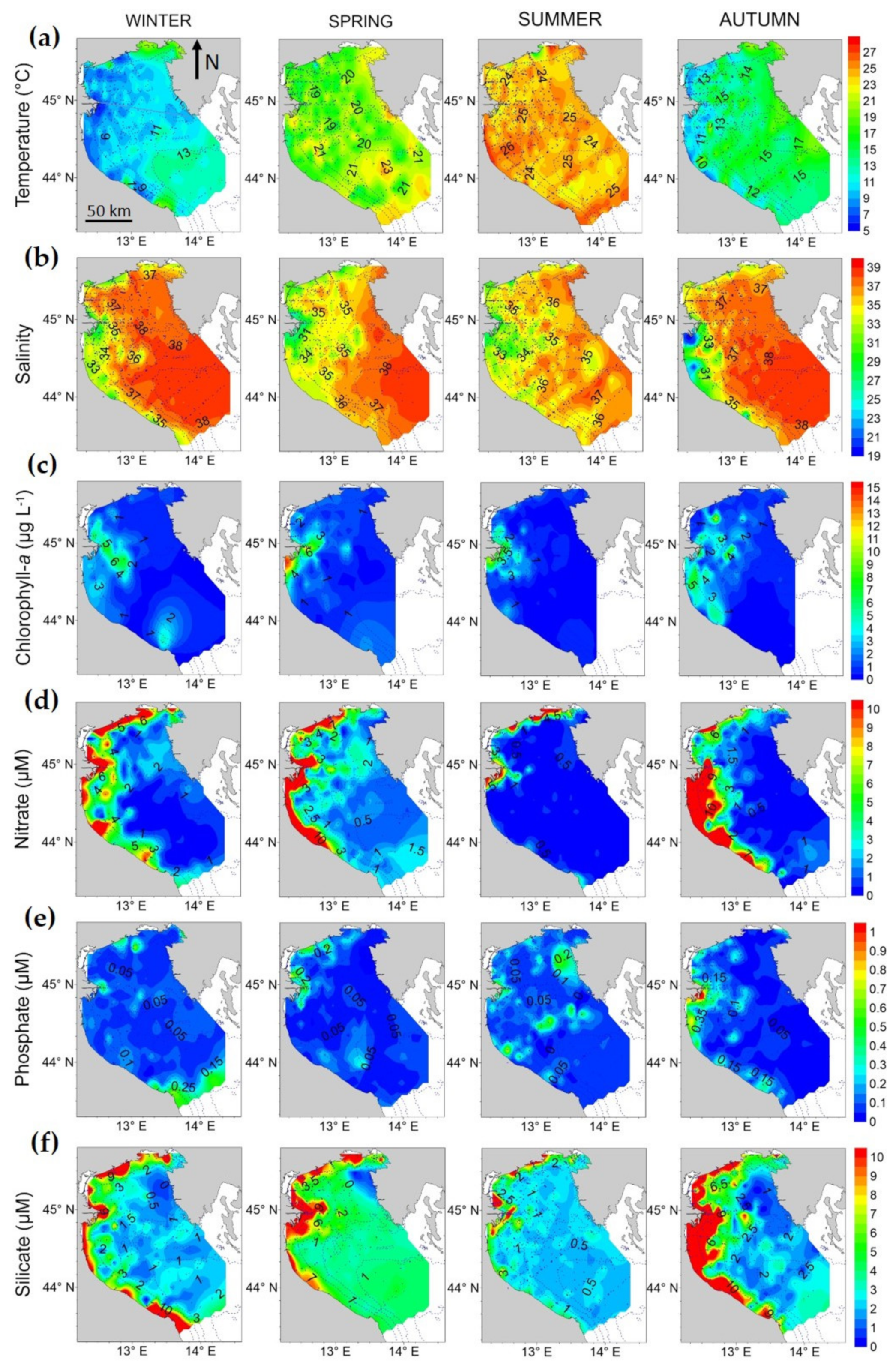
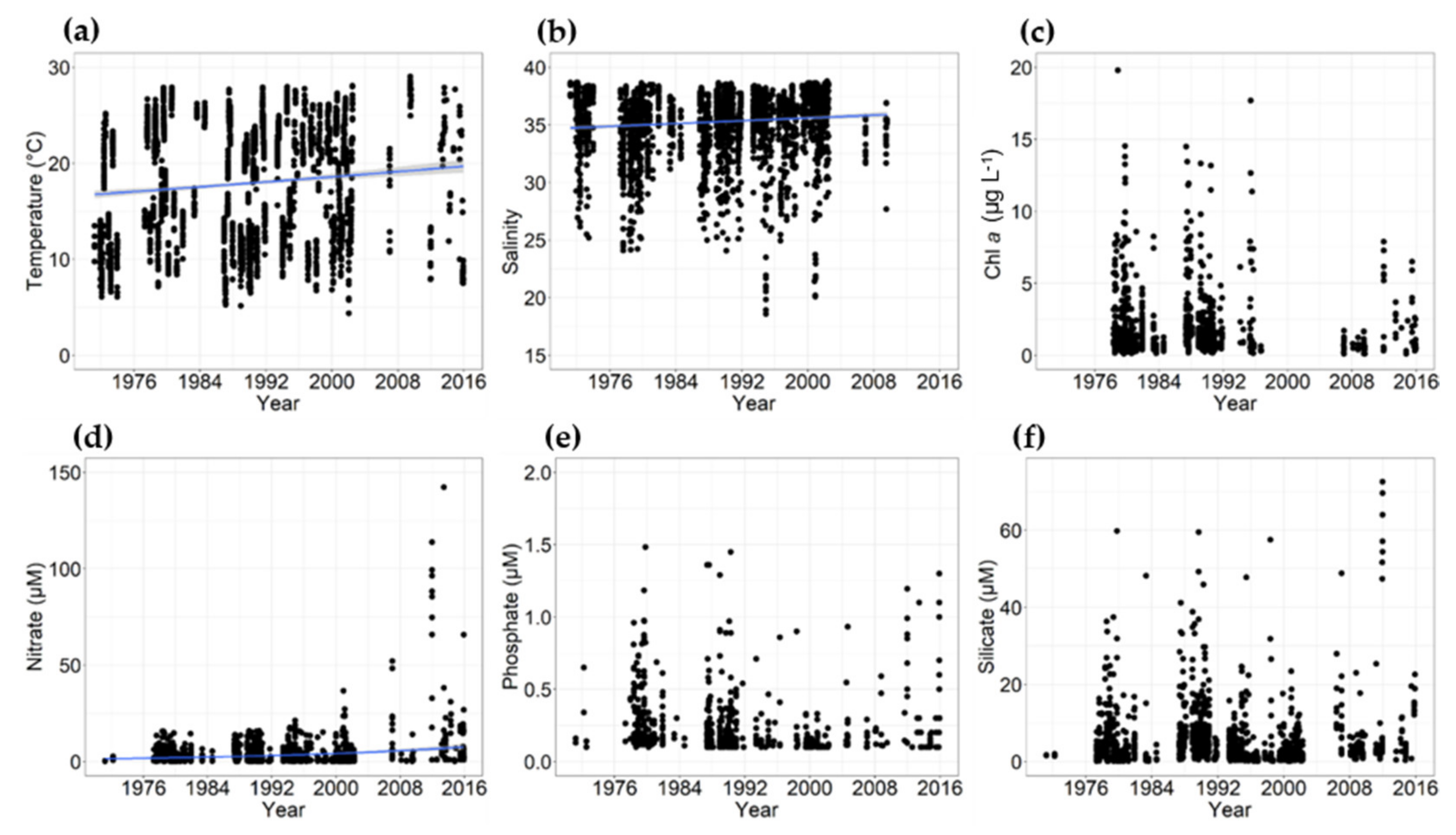
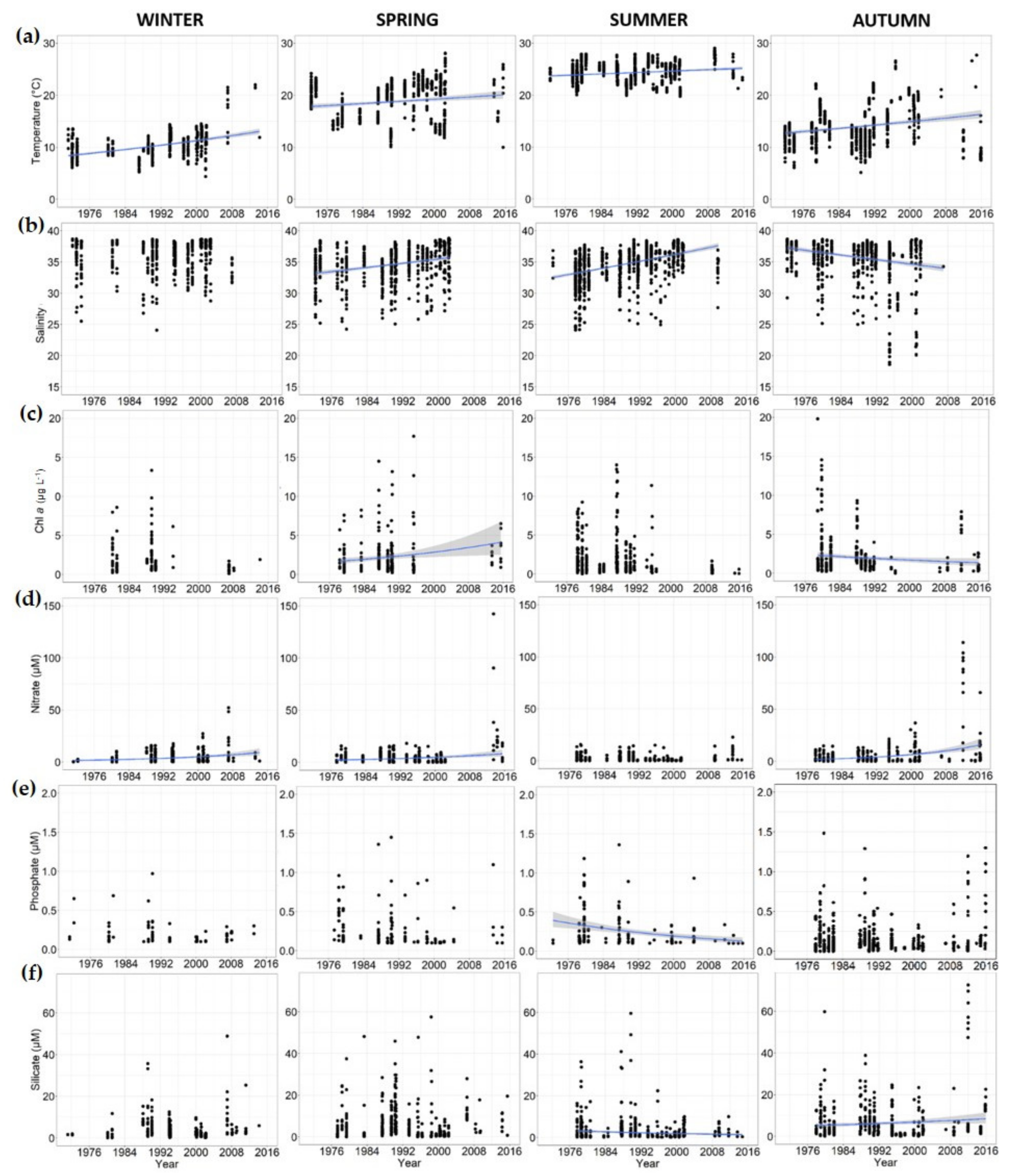

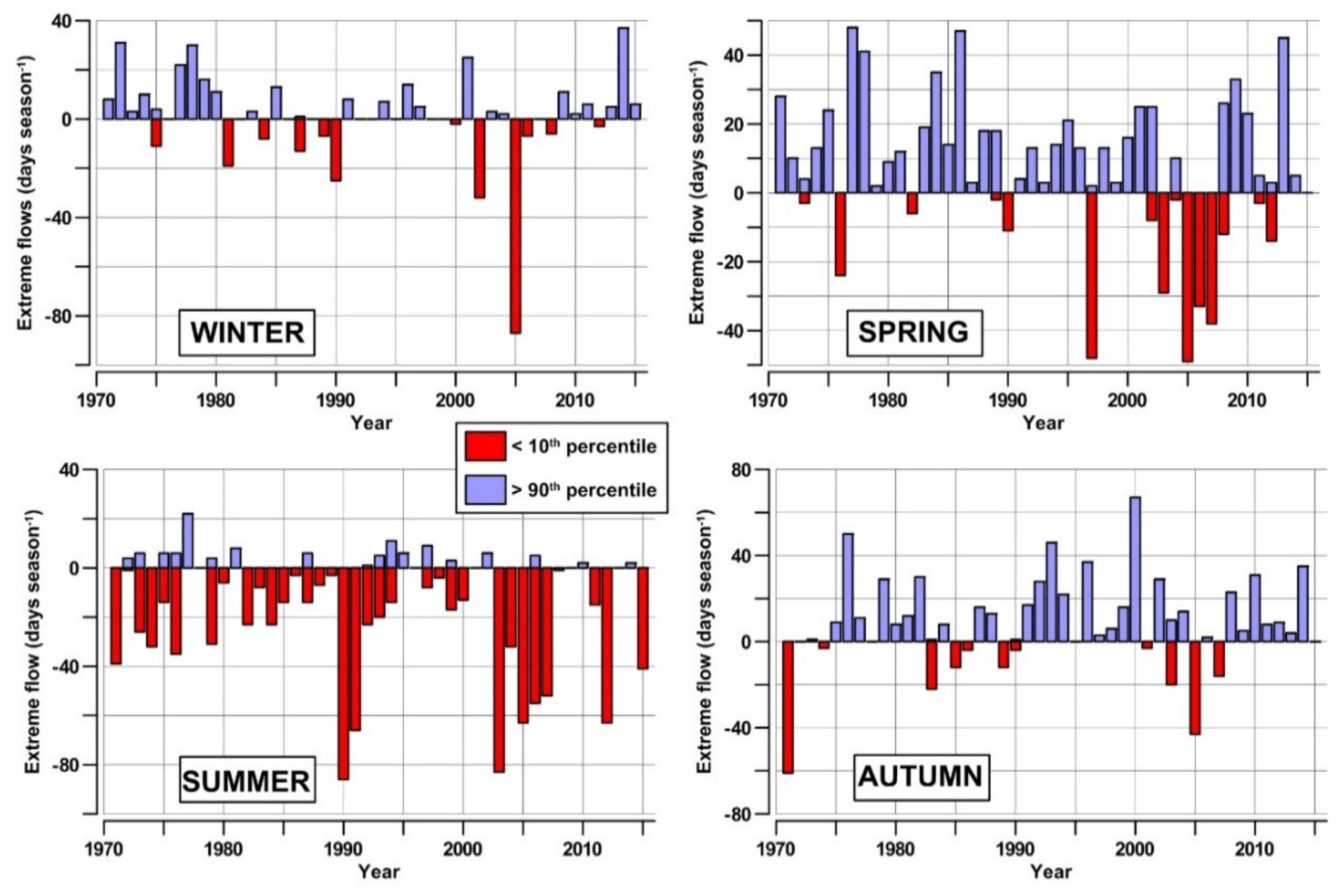
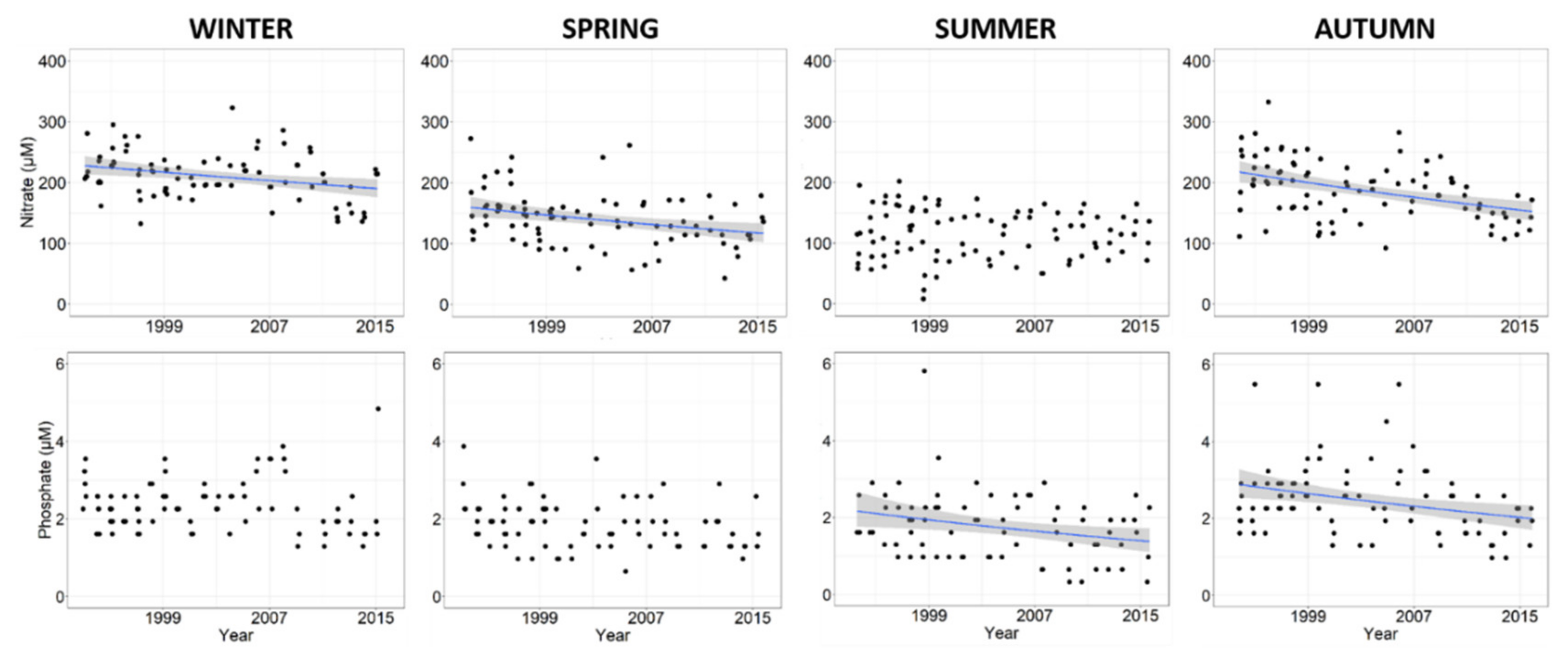
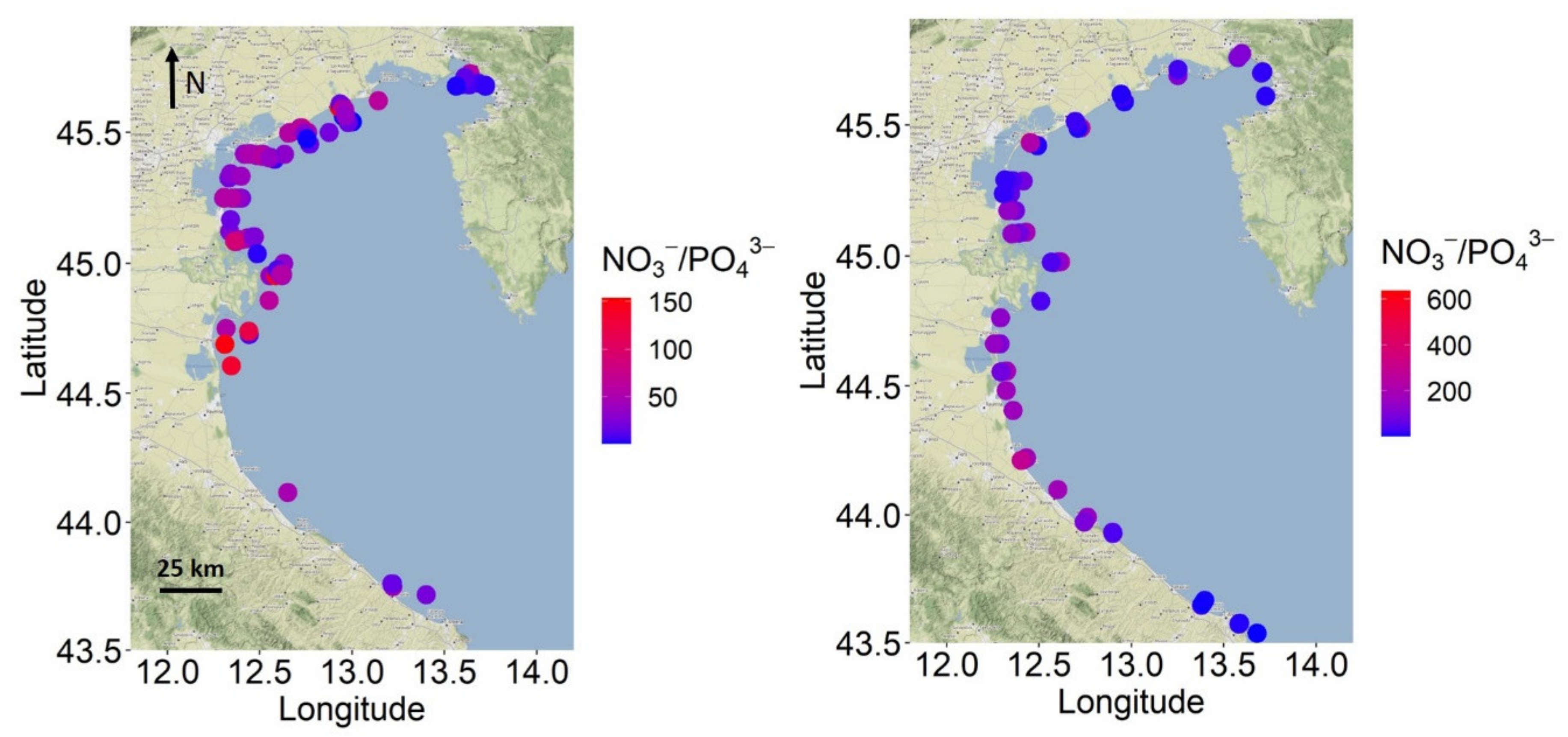
| Seasons | Winter | Spring | Summer | Autumn |
|---|---|---|---|---|
| Temperature (°C) | ||||
| No. data | 615 | 789 | 1183 | 907 |
| Mean | 10.5 | 18.8 | 24.24 | 13.67 |
| Standard Error | 0.12 | 0.13 | 0.05 | 0.13 |
| Minimum | 4.38 | 10 | 19.77 | 5.15 |
| Maximum | 23 | 28.08 | 29.03 | 27.7 |
| Salinity | ||||
| No. data | 602 | 705 | 1131 | 844 |
| Mean | 36.05 | 34.47 | 34.51 | 35.73 |
| Standard Error | 0.11 | 0.11 | 0.08 | 0.11 |
| Minimum | 24.07 | 24.23 | 24.1 | 18.58 |
| Maximum | 38.68 | 38.8 | 38.6 | 38.66 |
| Chlorophyll-a (µg L−1) | ||||
| No. data | 173 | 309 | 479 | 460 |
| Mean | 1.84 | 2.39 | 1.78 | 1.91 |
| Standard Error | 0.16 | 0.15 | 0.11 | 0.11 |
| Minimum | 0.1 | 0.05 | 0.05 | 0.05 |
| Maximum | 13.33 | 17.69 | 14.39 | 19.79 |
| Nitrate (µM) | ||||
| No. data | 364 | 490 | 987 | 584 |
| Mean | 5.83 | 4.89 | 1.55 | 6.44 |
| Standard Error | 0.66 | 0.5 | 0.12 | 0.64 |
| Minimum | 0.02 | 0.02 | 0.02 | 0.02 |
| Maximum | 132.5 | 142.3 | 45.4 | 181.25 |
| Phosphate (µM) | ||||
| No. data | 428 | 608 | 969 | 674 |
| Mean | 0.09 | 0.12 | 0.09 | 0.16 |
| Standard Error | 0.01 | 0.01 | 0.01 | 0.01 |
| Minimum | 0.03 | 0.03 | 0.03 | 0.03 |
| Maximum | 2.16 | 1.45 | 1.36 | 1.6 |
| Silicate (µM) | ||||
| No. data | 424 | 586 | 1044 | 668 |
| Mean | 4.86 | 5.84 | 2.63 | 7.71 |
| Standard Error | 0.35 | 0.37 | 0.18 | 0.39 |
| Minimum | 0.02 | 0.02 | 0.02 | 0.02 |
| Maximum | 73.77 | 67.3 | 59.5 | 85.81 |
| Parameter | Variation (% Year−1) | ||||
|---|---|---|---|---|---|
| Aggregated Data | Winter | Spring | Summer | Autumn | |
| Temperature (°C) | +0.36 | +2.98 | +0.27 | +0.14 | +0.57 |
| Salinity | +0.086 | ns | +0.24 | +0.39 | −0.26 |
| Chlorophyll-a (µg L−1) | ns | ns | +2.41 | ns | −1.34 |
| Nitrate (µM) | +3.80 | +0.011 | +2.71 | ns | +5.91 |
| Phosphate (µM) | ns | ns | ns | −2.56 | ns |
| Silicate (µM) | ns | ns | ns | −2.25 | +1.26 |
| Parameter | Variation (% Year−1) | ||||
|---|---|---|---|---|---|
| Aggregated Data | Winter | Spring | Summer | Autumn | |
| Nitrate (µM) | −1.02 | −0.81 | −1.40 | ns | −1.58 |
| Phosphate (µM) | −1.34 | ns | ns | −2.02 | −1.65 |
© 2020 by the authors. Licensee MDPI, Basel, Switzerland. This article is an open access article distributed under the terms and conditions of the Creative Commons Attribution (CC BY) license (http://creativecommons.org/licenses/by/4.0/).
Share and Cite
Grilli, F.; Accoroni, S.; Acri, F.; Bernardi Aubry, F.; Bergami, C.; Cabrini, M.; Campanelli, A.; Giani, M.; Guicciardi, S.; Marini, M.; et al. Seasonal and Interannual Trends of Oceanographic Parameters over 40 Years in the Northern Adriatic Sea in Relation to Nutrient Loadings Using the EMODnet Chemistry Data Portal. Water 2020, 12, 2280. https://doi.org/10.3390/w12082280
Grilli F, Accoroni S, Acri F, Bernardi Aubry F, Bergami C, Cabrini M, Campanelli A, Giani M, Guicciardi S, Marini M, et al. Seasonal and Interannual Trends of Oceanographic Parameters over 40 Years in the Northern Adriatic Sea in Relation to Nutrient Loadings Using the EMODnet Chemistry Data Portal. Water. 2020; 12(8):2280. https://doi.org/10.3390/w12082280
Chicago/Turabian StyleGrilli, Federica, Stefano Accoroni, Francesco Acri, Fabrizio Bernardi Aubry, Caterina Bergami, Marina Cabrini, Alessandra Campanelli, Michele Giani, Stefano Guicciardi, Mauro Marini, and et al. 2020. "Seasonal and Interannual Trends of Oceanographic Parameters over 40 Years in the Northern Adriatic Sea in Relation to Nutrient Loadings Using the EMODnet Chemistry Data Portal" Water 12, no. 8: 2280. https://doi.org/10.3390/w12082280
APA StyleGrilli, F., Accoroni, S., Acri, F., Bernardi Aubry, F., Bergami, C., Cabrini, M., Campanelli, A., Giani, M., Guicciardi, S., Marini, M., Neri, F., Penna, A., Penna, P., Pugnetti, A., Ravaioli, M., Riminucci, F., Ricci, F., Totti, C., Viaroli, P., & Cozzi, S. (2020). Seasonal and Interannual Trends of Oceanographic Parameters over 40 Years in the Northern Adriatic Sea in Relation to Nutrient Loadings Using the EMODnet Chemistry Data Portal. Water, 12(8), 2280. https://doi.org/10.3390/w12082280










